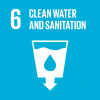Hydrocarbon contamination of water bodies in southern Nigeria appears as a sheen on the surface of water bodies. It appears due to the density difference between water and hydrocarbon. From hydro-geochemistry, I understand that these are light non-aqueous phase liquids (L-NAPLs). They are lighter than water, hence their ability to float. All hydrocarbons belong to this group. They are harmful to both humans and aquatic life.
Different processes cause the contamination, but the most problematic is from illegal oil bunkering, pipeline vandalism, and illegal oil scooping.
Consequences, if no action is taken include that inhabitants of the creeks will continue to drink and use hydrocarbon-contaminated water, for instance from the Okulu River which is a major source of drinking water for the local community. It has other adjoining rivers which empty into the Atlantic Ocean. Drinking the water is detrimental to their health and well-being.
SDG 6 states that there should be clean water and sanitation for all. Sadly, this is not the case for many in the Niger Delta area of Nigeria due to pollution from the supposed natural resource they have been blessed with.
It will be beneficial to create a unique spectral signature to identify the hydrocarbon pollution easily.
Find polygones for the outlines of affected areas and the suggested wetland extent mapping here.










